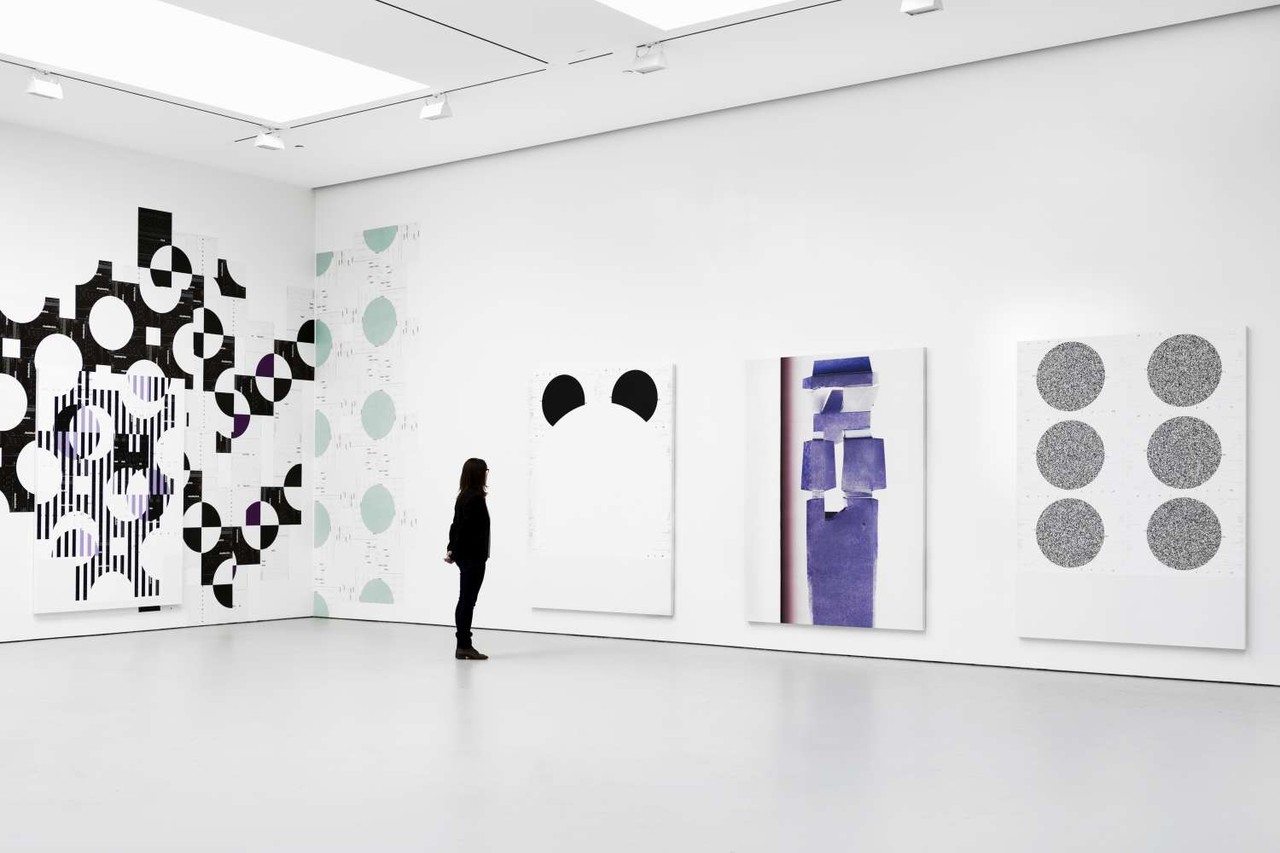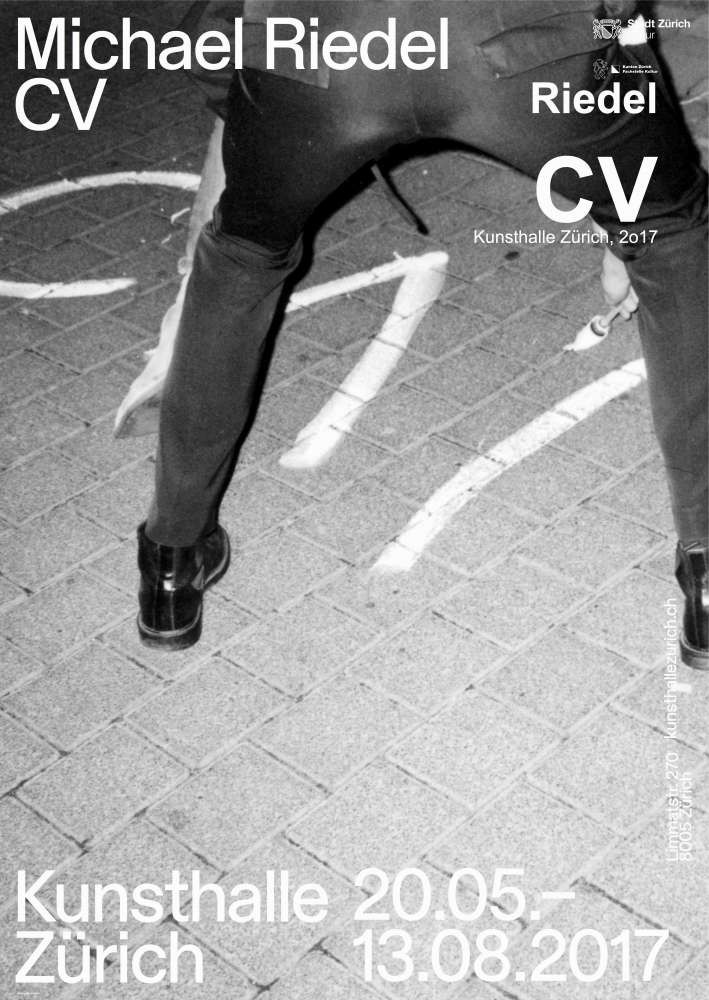Michael Riedel
CV
20 May - 13 Aug 2017

Michael Riedel. Photo by Jonathan Smith. Courtesy David Zwirner, New York/London and Gabriele Senn Galerie, Vienna.

Michael Riedel. Photo by Alex Delfanne. Courtesy David Zwirner, New York/London and Gabriele Senn Galerie, Vienna.
MICHAEL RIEDEL
CV
20 May - 13 August 2017
Michael Riedel (*1972) has spent the past twenty years in the creation of a body of work that is often misunderstood and bears almost no comparison with any other. Similar to the Gemini’s spell, by which an object through the most minimal contact is multiplied and then those multiplications come to be multiplied further, Riedel’s works are the temporal evidence of a perpetual process within the systems of art.
His exhibition CV in the Kunsthalle Zürich will take place twice. As an exhibition and as an automatic entry into Riedel’s own CV. Riedel’s main interest is in the performative discrepancy generated therein. Unfurling out of itself, this paradoxical form is then a perfect manifestation of Riedel’s artistic form of autonomy, which can be described as a reinsertion of the form into the form – CV into CV – each inducing a mutual irritation in the other. With this practice of reinsertion Riedel succeeds in speaking about made, non-made and to-be-made instances, ultimately the interplay between actuality and potentiality. Thus, over the course of the last two decades, a work has developed, one that in its formal brilliance, critical clarity and elegant hermeticism, reintroduces art as a copy into art, whereby artistic production becomes a virtually self-sufficient process.
The CV is today the universally accepted form for presenting oneself and demonstrates how an individual can enlist themselves in a system. It is a proof of accomplishment, a looking-glass and a legitimation. It always conceals more than it reveals. The unmentioned determines what is itemised in the same way that which is suppressed defines normality. It is no coincidence that Michael Riedel’s artistic career began with his own signature. In 1994 he turned his signature into a trade mark, proceeding to sign his own signature. This act of signification placed him exactly in that grey area where art perpetually machinates. Logically, the first action of the young artist was then to expand and otherwise name his own name as part of a performance of Michael S Riedel. From this followed an exhibition in Paris that never took place, but which he nonetheless had reviewed by a newspaper. He then displayed this review in the Städelschule, where he studied, on the door to the library; which in turn served as a noticeboard indicative of professional success. Only through this action was he able to discern the self-perpetuation within the written material itself. In this way a career was born, built out of voids within the system: the signed signature was an artwork that only referred to itself; the extension of the name to include the letter S points to the millions of possibilities to be another person; the non-exhibition points to the non-made, which every CV seeks to mask. Here an art form finds its inception, one that even today remains at once familiar and curiously alien. It is a strangeness that emanates from within, it is quite literally a foreign tongue. In his not-only-but-also-ism and his productive instability lies the beauty of Riedel’s art.
In the way that every entry in a CV simulates a new event in the ledger of experience, so will the exhibition CV numerously re-echo the act of entering: the entrance to the Kunsthalle Zürich will be re-built three times, so that the visitors will find themselves stepping anew into the exhibition. Turning over within itself, what was formerly the entrance will no longer be the entrance but in fact the exhibition. There will be no way back to what was experienced, just as if you had not actually visited the exhibition. This idea of the re-entries is a reiteration of the notion on which Michael Riedel’s whole artistic practice is founded. Riedel will also rework the formulation of the exhibition CV across its different sections over the entire exhibition space of Kunsthalle Zürich. Between 2000 and 2006, he worked in a similar way together with Dennis Loesch and a group of friends from Frankfurt am Main, using the project ‘Oskar-von-Miller Strasse 16’ to repeatedly address the idea of the culture industry: exhibitions were repeated, readings re-read, filmed films were shown, concerts restaged, existing clubs ‘re-clubbed’, performances re-performed, talks re-spoken and so forth.
Riedel applied the same method to the world of publishing, with newly ‘volumed’ volumes, posters used as archives, printed and non-printed posters bound as books, existing magazine formats freshly filled or colour publications separated into their founding colours (CMYK). Over the past few years, in a continuation of this, Riedel has extended his materials, which multiply as if by magic, to include digital tools: computer voices, programming, 3D, speech recognition and more. However, the artist does not use these programs as they were intended. Instead, he might order all the letters in a text alphabetically and have a computer read this new text aloud; generating a sound-poem, that recaps the original text to the letter, while remaining absolutely unfamiliar. While on Kunsthalle Zürich’s second floor the exhibition CV engages the visitor in the trinity of ‘idea-action-mediation’, the self-enactment of the art-systems proliferates on the third floor in the form of painting, graphics, installation, sound and participatory works. Here now, the space we call Art emerges, an expanded field, full of unexpected shallows and surprises, situated between the present time, a reactivated past and an abundant potential. DB
The exhibition will be accompanied by a catalogue (German/English) with texts by Michael Riedel and Daniel Baumann as well as installation views from the exhibition at the Kunsthalle Zürich.
The launch of the catalogue will be in the afternoon of Sunday, 11 June 2017. It will be accompanied by a talk between Daniel Baumann, Silke Hohmann (art critic), Jörg Heiser (art critic) and Michael Riedel (in German).
CV
20 May - 13 August 2017
Michael Riedel (*1972) has spent the past twenty years in the creation of a body of work that is often misunderstood and bears almost no comparison with any other. Similar to the Gemini’s spell, by which an object through the most minimal contact is multiplied and then those multiplications come to be multiplied further, Riedel’s works are the temporal evidence of a perpetual process within the systems of art.
His exhibition CV in the Kunsthalle Zürich will take place twice. As an exhibition and as an automatic entry into Riedel’s own CV. Riedel’s main interest is in the performative discrepancy generated therein. Unfurling out of itself, this paradoxical form is then a perfect manifestation of Riedel’s artistic form of autonomy, which can be described as a reinsertion of the form into the form – CV into CV – each inducing a mutual irritation in the other. With this practice of reinsertion Riedel succeeds in speaking about made, non-made and to-be-made instances, ultimately the interplay between actuality and potentiality. Thus, over the course of the last two decades, a work has developed, one that in its formal brilliance, critical clarity and elegant hermeticism, reintroduces art as a copy into art, whereby artistic production becomes a virtually self-sufficient process.
The CV is today the universally accepted form for presenting oneself and demonstrates how an individual can enlist themselves in a system. It is a proof of accomplishment, a looking-glass and a legitimation. It always conceals more than it reveals. The unmentioned determines what is itemised in the same way that which is suppressed defines normality. It is no coincidence that Michael Riedel’s artistic career began with his own signature. In 1994 he turned his signature into a trade mark, proceeding to sign his own signature. This act of signification placed him exactly in that grey area where art perpetually machinates. Logically, the first action of the young artist was then to expand and otherwise name his own name as part of a performance of Michael S Riedel. From this followed an exhibition in Paris that never took place, but which he nonetheless had reviewed by a newspaper. He then displayed this review in the Städelschule, where he studied, on the door to the library; which in turn served as a noticeboard indicative of professional success. Only through this action was he able to discern the self-perpetuation within the written material itself. In this way a career was born, built out of voids within the system: the signed signature was an artwork that only referred to itself; the extension of the name to include the letter S points to the millions of possibilities to be another person; the non-exhibition points to the non-made, which every CV seeks to mask. Here an art form finds its inception, one that even today remains at once familiar and curiously alien. It is a strangeness that emanates from within, it is quite literally a foreign tongue. In his not-only-but-also-ism and his productive instability lies the beauty of Riedel’s art.
In the way that every entry in a CV simulates a new event in the ledger of experience, so will the exhibition CV numerously re-echo the act of entering: the entrance to the Kunsthalle Zürich will be re-built three times, so that the visitors will find themselves stepping anew into the exhibition. Turning over within itself, what was formerly the entrance will no longer be the entrance but in fact the exhibition. There will be no way back to what was experienced, just as if you had not actually visited the exhibition. This idea of the re-entries is a reiteration of the notion on which Michael Riedel’s whole artistic practice is founded. Riedel will also rework the formulation of the exhibition CV across its different sections over the entire exhibition space of Kunsthalle Zürich. Between 2000 and 2006, he worked in a similar way together with Dennis Loesch and a group of friends from Frankfurt am Main, using the project ‘Oskar-von-Miller Strasse 16’ to repeatedly address the idea of the culture industry: exhibitions were repeated, readings re-read, filmed films were shown, concerts restaged, existing clubs ‘re-clubbed’, performances re-performed, talks re-spoken and so forth.
Riedel applied the same method to the world of publishing, with newly ‘volumed’ volumes, posters used as archives, printed and non-printed posters bound as books, existing magazine formats freshly filled or colour publications separated into their founding colours (CMYK). Over the past few years, in a continuation of this, Riedel has extended his materials, which multiply as if by magic, to include digital tools: computer voices, programming, 3D, speech recognition and more. However, the artist does not use these programs as they were intended. Instead, he might order all the letters in a text alphabetically and have a computer read this new text aloud; generating a sound-poem, that recaps the original text to the letter, while remaining absolutely unfamiliar. While on Kunsthalle Zürich’s second floor the exhibition CV engages the visitor in the trinity of ‘idea-action-mediation’, the self-enactment of the art-systems proliferates on the third floor in the form of painting, graphics, installation, sound and participatory works. Here now, the space we call Art emerges, an expanded field, full of unexpected shallows and surprises, situated between the present time, a reactivated past and an abundant potential. DB
The exhibition will be accompanied by a catalogue (German/English) with texts by Michael Riedel and Daniel Baumann as well as installation views from the exhibition at the Kunsthalle Zürich.
The launch of the catalogue will be in the afternoon of Sunday, 11 June 2017. It will be accompanied by a talk between Daniel Baumann, Silke Hohmann (art critic), Jörg Heiser (art critic) and Michael Riedel (in German).


